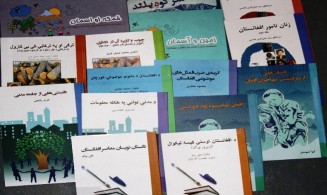Programme Overview
| Programme Title | National Education Programme for Illiterate Youth and Adults through Information and Communication Technologies (Programme National d’Éducation des Jeunes et des Adultes Analphabètes articulé aux Technologies de l’Information et de la Communication, PNEBJA-TIC) |
|---|---|
| Implementing Organization | Directorate for Literacy and National Languages in Senegal (Direction de l’Alphabétisation et des Langues Nationales, DALN) |
| Language of Instruction | French, Wolof, Sérère, Pulaar, Joola, Soninke, Womey and Mandinka |
| Funding | Government of Senegal |
| Programme Partners | National Ministry of Education, Illiterate Youth and Adult Basic Education (Ministère de l’Éducation Nationale, sous secteur de l’Éducation de Base des Jeunes et des Adultes Analphabètes, EBJA), National Centre for Educational Resources (Centre National de Resources Éducationnelles, CNRE), Office of the Secretary of State for Literacy and National Languages Promotion (Cabinet du Secrétaire d’Etat à l’Alphabétisation et à la Promotion des Langues Nationales, SEAPLN), UNESCO, and Regional Centres for Education Staff Training (Centres Régionaux de Formation des Personnels de l’Éducation, CRFPE). |
| Annual Programme Costs | US $960,000 (for each of the four years of commitment). Annual cost per participant: US $70–$80. |
| Date of Inception | 2012 |
Country Context
Senegal was ranked 102nd out of 113 countries in the Education for All (EFA) Development Index (UNESCO, 2012) and 170th out of 188 in the Human Development Report (UNDP, 2015). Although it is still classed among the countries with lower rates of human development, in past decades there have been significant improvements with regard to literacy: youth literacy rates (for people aged 15–24) increased from 37.9 per cent in 1988 to 69.8 per cent in 2015, while adult literacy rates (for people aged 15 years and over) increased from 26.9 per cent in 1988 to 55.6 per cent in 2015 (UIS, 2016). Despite improvements, more than two-thirds of the population in Senegal continues to live on less than US $2 per day (UIS, 2016). According to the Human Development Report 2015, more than half the total population face challenges in accessing education, health and support services. Unemployment has risen to 10.4 per cent of the total labour force, while 12.7 per cent of the total youth labour force is unemployed (UNDP, 2015).
In recent years, the primary school enrolment rate has increased, from 63.8 per cent in 2005 to 71.1 per cent in 2014. However, the rate of survival to the last grade of primary school is still only 61.4 per cent. In 2014, there were more than 634,000 children out of school (UIS, 2016), many of them likely later to join the group of youth and adults with poor literacy skills.
Despite the government’s investment in education, which represented around 5.6 per cent of GDP in 2010 (UIS, 2016), large disparities remain. In 2015, more than 3.7 million adults in Senegal lacked literacy skills, 2.5 million of them women (nearly 70 per cent). In the same year, around 898,000 young people aged between 15 and 24 were also found to lack literacy skills. Some half a million of these (60 per cent) were young women (UIS, 2016).
Following the progress achieved in recent decades, Senegal continues its efforts in the promotion of literacy, to improve the living conditions of its population as well as to contribute to the fulfilment of Agenda 2030 and the Sustainable Development Goals. It does so by working on existing educational policies in three key areas – access, quality and governance – prioritizing literacy and the acquisition of basic skills, in order to promote socio-economic integration, citizenship and lifelong learning.
Programme Overview

National Education Programme for Illiterate Youth and Adults through Information and Communication Technologies (or PNEBJA-TIC, its abbreviation from French) is a national literacy programme developed by the Government of Senegal. Launched in December 2012, it has been implemented in 460 locations across Senegal since 2013. It is a national basic education programme for young people and adults lacking basic literacy skills, designed around the use of information and communications technology (ICT).
PNEBJA-TIC targets around 14,100 learners per year in the adult age group (15 or older). It provides literacy and everyday life skills for people who have never been to school or who have left early, allowing them to improve their basic skills, living conditions and socio-economic environment through the utilization of ICTs.
The programme’s planned duration is 13 years, as it is part of the broader Illiterate Youth and Adults Education Development Plan 2012–2025 (PDEBJA) designed and implemented by the national Ministry of Education.
The programme’s main implementing authority is the Directorate for Literacy and National Languages in Senegal (DALN). DALN is responsible for the implementation of the government's general policy regarding literacy, basic education and national languages promotion.
A number of actors and partners are involved in the implementation of PNEBJA-TIC:
- The Ministry of Education, mainly through the illiterate youth and adult basic education subsector (EBJA): general monitoring and supervision of the execution of the programme.
- The National Centre for Educational Resources (CNRE): general monitoring and supervision of the execution of the programme.
- The Office of the Secretary of State for Literacy and National Languages Promotion (SEAPLN): general monitoring and supervision of the execution of the programme.
- The Regional Centres for Education Staff Training (CRFPE): staff training.
- UNESCO: support by means of educational material and in other areas such as promoting the development of a literacy staff database and staff training certification.
PNEBJA-TIC is based on the experience of a previous programme, the Literacy Project for Girls and Women in Senegal (PAJEF). This programme was set up by the UNESCO office in Dakar in January 2012 and implemented in collaboration with several agencies of the national Ministry of Education, including DALN. The positive impact of the previous project prompted DALN to develop a new programme, PNEBJA-TIC, acting this time as the main implementing authority. To learn more about the Literacy Project for Girls and Women in Senegal, follow this link.
PNEBJA-TIC falls within the scope of the Literacy Acceleration Plan in Senegal (Plan d’Accélération de l’Alphabétisation au Sénégal or PAAS), created by the national government under the framework of the ‘Big Push’ initiative for Africa with the aim of achieving a substantial increase in literacy levels.

The programme is also in line with the Government of Senegal’s policy on decentralization, which strives to improve the quality of education services at the local level. PNEBJA-TIC has been implemented on a national and local scale, across all 14 regions of Senegal: Dakar (including the departments of Dakar, Guédiawaye, Pikine and Rufisque), Diourbel, Fatick, Kaffrine, Kaolack, Kédougou, Kolda, Louga, Matam, Saint-Louis, Sédhiou, Tambacounda, Thiès and Ziguinchor.
The programme offers educational opportunities to learners of various ages, including young people, adults and elderly people (65 and over), and focuses primarily on women and girls. In a 2016 evaluation, women and girls accounted for 97 per cent of the total evaluated learners across the several regions where the programme was implemented. The average age of participants is 30. PNEBJA-TIC reaches citizens belonging to rural, minority and marginalized populations, and also people with special needs.
Aims and Objectives
PNEBJA-TIC aims to improve literacy rates in Senegal by 2030, to promote access to education and to improve the living conditions of participants in all regions of the country. Other goals include:
- To contribute to the empowerment of Senegal’s citizens, especially women and girls, and to help overcome poverty through the provision of basic education.
- To provide literacy and everyday life skills in the national languages or in the official language, in particular to women and girls, in order to foster their active participation in their communities and society as a whole.
- To enable programme beneficiaries to use ICTs and promote their transition into the labour market as well as their socio-economic environment.
- To enable local communities to contribute to the implementation of the programme.
- To foster the development of national human resources to attain sustainable development.

Programme Implementation
Teaching and Learning: Approaches and Methodologies
The programme is implemented through a combined learning approach: on the one hand, delivering reading/writing and calculus training sessions in the literacy and numeracy modules, and, on the other, carrying out practical sessions on ‘income-generating activities’ (activités génératrices de revenus or AGR) and social studies sessions called ‘social modules’.
The basic literacy and numeracy modules are offered in order to strengthen participants’ basic skills, so that they can later apply them in the income-generating activities module and in the social module. In the following section, the contents of these modules are further explained.
All the modules use ICTs and different media/digital resources to introduce topics for debate on specific subjects, for example, through the screening of short films. Another example is using the calculator application on mobile phones for problem-solving. This way, participants are able to improve their IT skills at the same time as they develop their literacy and mathematical skills.
PNEBJA-TIC runs for nine months per year, from June to February. Each lesson lasts two hours and classes are held four times a week: a total of 300 hours of instruction per academic year. Throughout the year, learners are able to take part in 12 modules, each lasting approximately 25 hours. On average, the teacher-learner ratio is one to 30.
The lessons take place in primary school classrooms, which are available to programme participants when formal students are not using the premises. This helps establish and maintain a strong connection between adults and children since the latter may witness their own parents attending their school. It also enables local communities to take ownership of the learning facilities in their villages and supports a more efficient utilization of local infrastructures.
Different languages are used for the purposes, including French, the official language of Senegal, and other national languages such as Balant, Joola, Mandinka, Manjaku, Onyan, Pulaar, Sérère, Soninké and Wolof. Participants choose whether they want to take lessons in the official language or in any other of the national languages available at the local chapter.

Programme Content and Teaching Material
The teaching methodology applied in PNEBJA-TIC is based on the National Basic Education Curriculum (Curriculum de l’Éducation de Base or CEB). This is a competency-based curriculum that prioritises learners' performance and focuses on the development of skills throughout the learning process. The content and structure of PNEBJA-TIC have been adapted to be delivered within the programme’s annual workload of 300 hours of instruction. The subjects taught are divided into three areas:
- Language and communication: oral communication, reading comprehension, writing and text production.
- Mathematics: arithmetic, calculations and problem-solving.
- Everyday life skills: the content of this area varies from one region to another; specific subjects may be included if they are especially relevant to the region in question.
The above areas constitute the basis for programme content and are subject to adaptation, so that the programme can meet specific needs that may arise during implementation. Taking these needs into consideration, the National Centre for Educational Resources defines the division of modules and contents to be included, as well as the integration of ICTs in the proposed contents.
The areas of ‘language and communication’ and ‘mathematics’ present in the CEB have been maintained, though reduced in total workload in comparison to formal education, and with a greater emphasis on the integration of ICTs. The area of everyday life skills has been added to the standard CEB contents, and comprises the income-generating activities module (AGR) and the social modules.
In the AGR module, the learners acquire knowledge and practical skills on a subject of their choice. Each class selects an area of expertise from several options, including management and registry of documents, animal feeding and nutrition, dyeing fabric, trade, horticulture, manufacture of soap, and the processing of local products. Learners receive special training in the chosen area and build up capacities that will enable them to engage in income-generating activities at the end of the programme. The reading, writing and arithmetic skills acquired by the learners in the basic modules are integrated into AGR by means of problem-solving exercises. For example, if the class has chosen to start a fruit and vegetables garden in the AGR module, their lessons and activities will focus on developing the participants’ notions of weight, surface area, costs, prices and convenience of purchase. In this module, each class receives financial support of US $200 to be used for the development of income-generating activities. The possibility of starting up an income-generating activity fosters the collaboration of the class with their community and helps forge a strong connection between the literacy programme and the local villages.
The social modules, in turn, deal with subjects such as the fight against malnutrition, the fight against AIDS, preservation of the environment, and health and hygiene. The inclusion of these social modules in the programme allows learners to develop essential skills for their daily life and to improve their wellbeing and environmental awareness.
In both the AGR and the social modules, the facilitator may call in a specialist in the subject so that the participants receive more specific training, while the learners may be required to organize exercises and do practical presentations in order to practice and demonstrate the recently acquired skills.
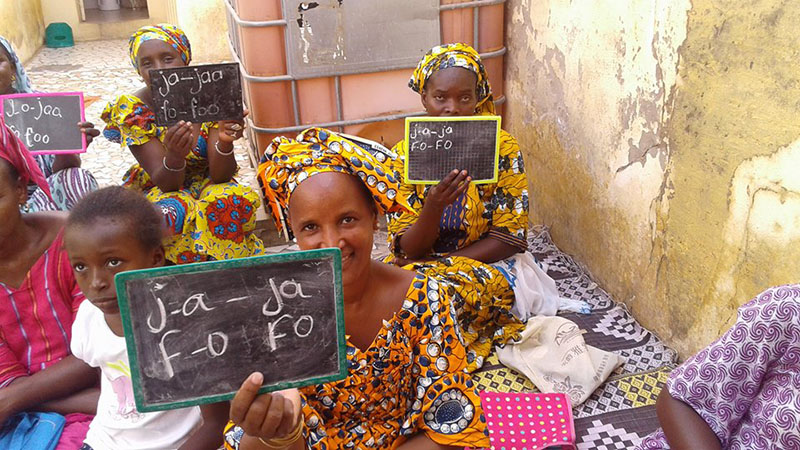
Learning Materials
Teachers have a facilitator’s guide and the learners are provided with textbooks, developed by DALN. Materials are available in CD and USB formats.
Most classes have a digital kit with digital pedagogic resources. The kit, which is produced with the support of UNESCO and is called the ‘Sankoré kit’, was also used in the Literacy Project for Girls and Women in Senegal programme. It is designed to encourage participation and to promote active learning, and is equipped with the software ‘Open Sankoré’, which is very simple to operate, along with other components: a laptop, a video projector, an interactive beamer and an infrared stylus touch pen which is used to write on a digital board. More information on the use of this technology and its installation is provided on the Sankoré website.
In total, 78 classrooms around the country are equipped with the Sankoré digital kit. However, many of the villages where the programme is implemented do not have access to the internet, which is why some classes have access to the material through USB sticks.
A 2016 evaluation by DALN showed that the majority of PNEBJA-TIC classrooms were adequately equipped with desks, chairs, tables and benches, and that most of them were suitable in terms of space, air, brightness and security. Regarding study materials, the classrooms had sufficient notebooks, pens, boards and reading and mathematics manuals (an average of 28 manuals of each kind for every class).
In addition, DALN has recently established a documentation and information centre through which it has been able to supply books in national languages to the local chapters where PNEBJA-TIC is implemented, enabling them to set up reading rooms or reading corners within classrooms.
Recruitment and Training of Teachers and Facilitators
PNEBJA-TIC teachers and facilitators are paid and are employed full-time. The teachers have professional experience in the formal education system (primary school) and are in charge of the programme’s lessons outside of their normal school hours. The facilitators are recruited exclusively for PNEBJA-TIC. This recruitment is carried out by the Agencies for the Supervision of Education and Training, who select the most qualified facilitators by means of a recruitment test.
The teachers and facilitators are qualified to different levels. They may hold a teacher’s diploma, a bachelor’s degree, a certificate of professional training or other kind of relevant qualification. All have several years of experience in the literacy field and participate in mandatory pre-service and in-service training sessions specific to PNEBJA-TIC. Although it varies from region to region, their average years of experience in 2014 was nine years. During 2014, 96 per cent of teachers and facilitators received training.
The local management committees also receive training on the administration of activities and the overall execution of the programme. In 2014, 67.8 per cent of the local management committees were trained.
UNESCO has been supporting PNEBJA-TIC through the Capacity Development for Education for All (CapEFA) Programme, now called Capacity Development for Education 2030 (CapED). Initially, it provided staff training but this task has more recently been carried out exclusively by the Senegalese Regional Centres for Education Staff Training (CRFPE). UNESCO provided support to the regional centres to take over the staff training functions, and also supported the development of a database that provides information on the literacy staff currently available in Senegal.
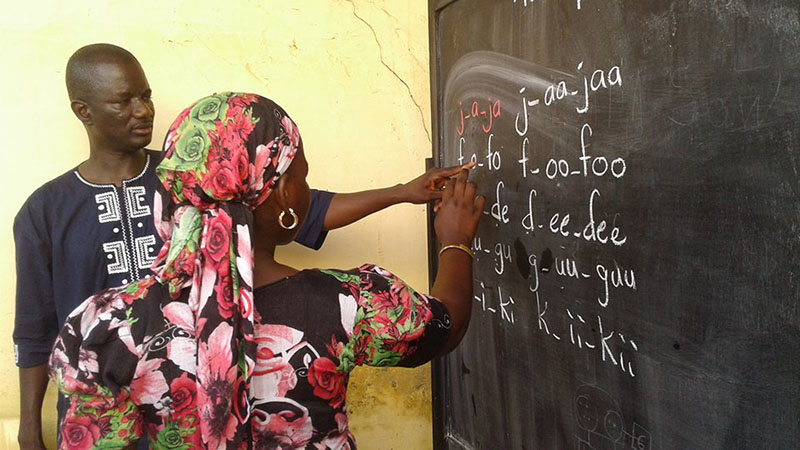
Staff training is based on the CEB, which has been translated into 22 codified national languages in order to allow facilitators and teachers from as many regions as possible to access training. The training sessions that facilitators receive amount to approximately 120–130 hours and last between 20 days and one month.
During their training, teachers and facilitators take part in a special module session entitled ‘Integration of ICTs’ that supports the development of skills related to the utilization and integration of ICTs in the classroom. They are trained in basic ICT concepts, tools, methods and techniques related to the use of computers and mobile phones, as well as in how to operate the interactive digital board used in the lessons. They also learn about operating systems such as Windows and Ubuntu (the operating system with which the majority of computers used in PNEBJA-TIC are equipped, compatible with the Sankoré digital kit).
At the end of the year, teachers and facilitators are awarded with a certificate that attests to their participation in PNEBJA-TIC. In addition, the Government of Senegal – with the assistance of UNESCO – has instituted an initiative called ‘Valorisation of Years of Experience’ (Valorisation des Années de l’Expérience or VAE). This initiative allows facilitators and teachers in the field of literacy to have their years of experience recognised and validated. This way, they can benefit from having an appropriate certification for their work to further plan and pursue their professional career. The VAE initiative plays a significant role in incentivizing them to get further training in the field of literacy and other contents delivered under PNEBJA-TIC.
Enrolment of Learners and Needs Assessment
The needs of the population and local communities are identified at the beginning of each yearly session of PNEBJA-TIC. Decisions concerning the distribution of literacy classes among the regions are based on school enrolment and poverty rates, so as to favour localities that are more in need and that could better benefit from the programme.
DALN carries out communication and outreach activities to inform local communities about the programme and to attract potential learners. Once the programme starts, other activities are organized in order to raise awareness about the importance of literacy, with the objective of promoting attendance and reducing dropout.
Before the classes start, potential participants' literacy skills are assessed. This assessment takes place at the local chapter and requires answering a questionnaire involving reading and writing exercises. The questions concern applicants' economic situation and possible prior attendance at formal school. The programme recognizes prior learning according to the level of instruction previously achieved by learners.
Assessment of Learning Outcomes
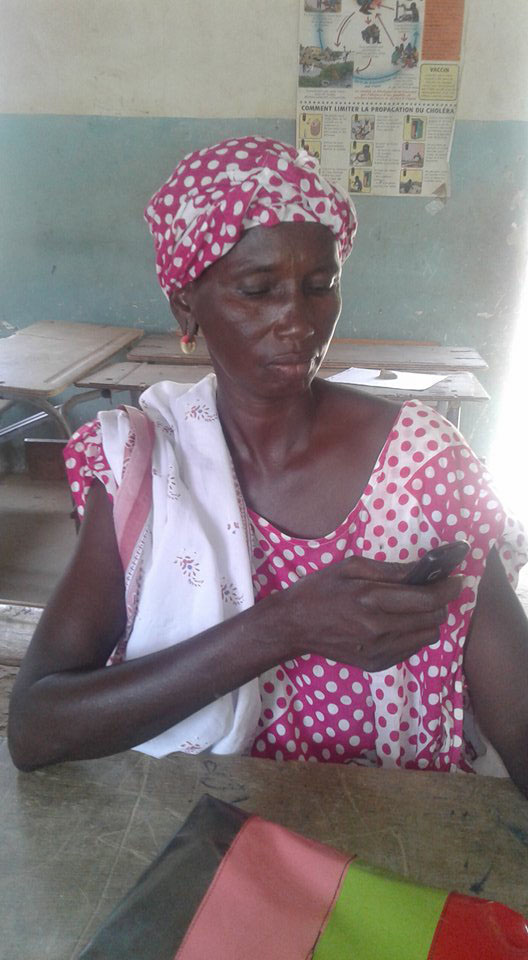
In order to successfully complete each learning module, the learners have to take part in assessment activities once every three months. Every learner is provided with a booklet which includes an assessment section with questions and exercises related to what they have learned during the classes. The participants are required to complete such exercises and submit them to the facilitators on a defined deadline. After that, the learners are graded individually according to their performance.
Once the learners successfully finish the programme (by completing the required number of credit hours and the assessment activities), they receive a certificate that attests to their attendance to the literacy programme (Certificat de frequentation d’un programme d’alphabétisation). The certificate allows them to continue their learning in the formal education system, starting from the last level of primary school (6th grade), and/or to enter the workforce. The validation and accreditation of qualifications under PNEBJA-TIC follows the national framework of qualifications and the Literacy Acceleration Plan in Senegal.
Monitoring and Evaluation
Evaluation takes place at different stages throughout the programme.
DALN is responsible for the quality of the programme and its monitoring and evaluation, which is carried out in a centralized way, in collaboration with the CNRE. Centralized monitoring allows for a complete assessment of the results at the decentralized levels and their conformity with the programme objectives.
At decentralized level, monitoring and evaluation is carried out by the Agencies for Academy Supervision (Inspections d’ Académie or IA) and the Agencies for the Supervision of Education and Training (Inspections de l’ Éducation et de la Formation or IEF), which regularly visit the local chapters of the programme and supervise and coach local providers.
Monitoring is also carried out by means of the so-called ‘educational animation cells’. These animation cells are sessions in which teachers and facilitators from the same region meet and practice a lesson of their choice. The innovative feature of these sessions is that they are interactive and collaborative: the facilitators are in charge of the session and have the opportunity to demonstrate on a subject of interest among the contents of the programme. Later, they receive feedback and a performance assessment by their colleagues, in order to improve teachers' knowledge and skills in a practical, collaborative way.
After every annual session of the programme, a questionnaire is submitted to the local communities where the classes take place to gather information about the level of satisfaction, the challenges experienced and recommendations for the future. In the case of local villages, the person in charge of submitting this questionnaire is the chief or mayor of the village. A special questionnaire is also handed to and submitted by the facilitators, the management committees and by each PNEBJA-TIC class, in order to collect feedback from all stakeholders.
After the 2014 delivery of PNEBJA-TIC, DALN carried out a final evaluation of the programme in all the regions of Senegal. The report showed that 86.5 per cent of learners achieved the level of competences expected under the programme. This average encompasses different average levels of achievement among disciplines: 92 per cent in language and communication, 85 per cent in everyday life skills, and 71.5 per cent in mathematics.
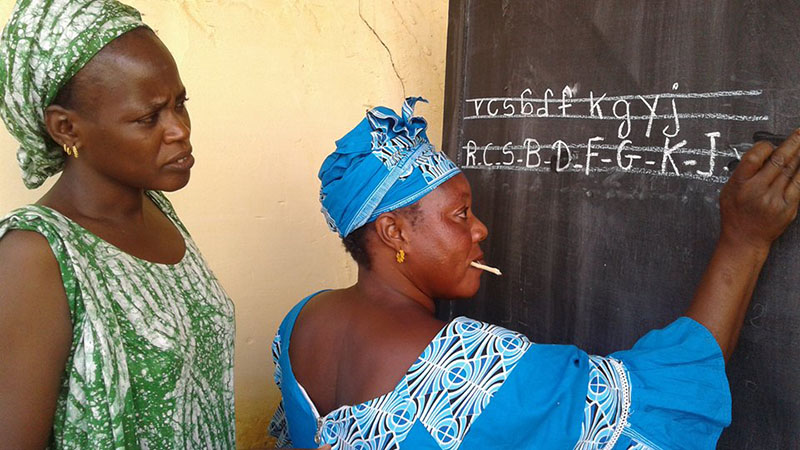
Impact and Challenges
Impact and Achievements
Since the beginning of the programme there have been many achievements:
- 13,800 enrolled participants per year for the period 2013–2015 (a total of around 55,000 enrolled participants).
- 14,100 enrolled participants in 2016.
- An average completion rate of 85 per cent.
- 97 per cent of learners are women.
- All 45 departments of the country have at least five literacy classes under this programme.
- 78 classrooms around the country are equipped with the Sankoré digital kit.
- Between 460 and 470 facilitators/teachers per year have received approximately 120–130 hours of specific training for PNEBJA-TIC.
In 2014:
- 89 per cent average attendance rate, substantially improving on the previous years’ figures.
- 86.5 per cent of participants successfully completed the level of competences required.
- 96 per cent of the teachers/facilitators participated in specific training sessions.
- 97 per cent of the local chapters had sufficient reading and mathematics manuals (an average of 28 manuals by type, per class).
- 82 per cent of the local chapters had a reading room available.
In 2015:
- A total of 13,800 enrolled participants, out of which 12,800 were women.
- 12,655 participants successfully completed the programme, out of which 12,342 were women.
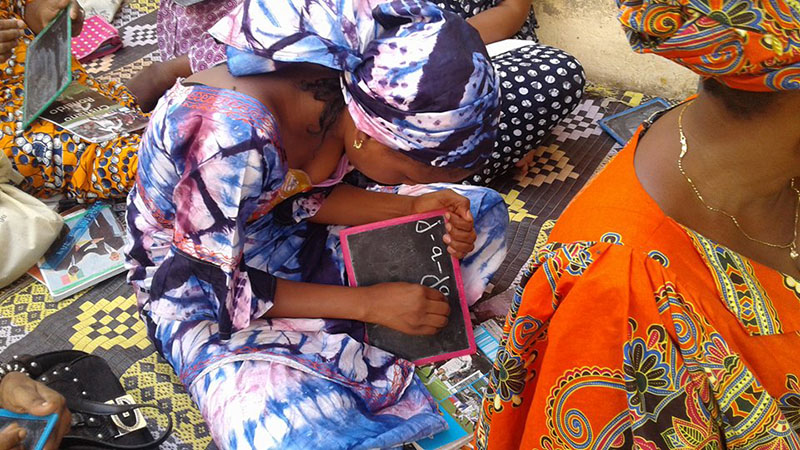
Local communities have progressively become more engaged in PNEBJA-TIC activities, especially as a result of the income-generating activities and the social modules, which address the population’s most crucial needs and problems. Many Senegalese families and communities were able to improve their economic situation and strengthen their finances due to the skills that participants acquired during the programme.
PNEBJA-TIC has had a great impact, simultaneously promoting literacy, labour training, women’s empowerment and environmental awareness. In the field of health, the programme has contributed to raising health awareness and tackling malnutrition in local communities.
PNEBJA-TIC has also benefited the participating teachers and facilitators, providing them with specific training on ICTs and allowing them to receive appropriate certification for their professional experience in the field of literacy, by means of the ‘Valorisation of Years of Experience’ initiative.
Challenges and Lessons Learned
During the implementation of PNEBJA-TIC, various challenges were faced and several lessons were learned. According to the 2016 evaluation report, these included:
- An average dropout rate of 9.48 per cent and difficulties promoting attendance of male participants, mostly in gold-mining regions where there is a high demand for intensive labour, such as Kédougou and the South-Eastern region of the country. To tackle the dropout rate and the relatively low levels of attendance of male participants, DALN has organized outreach activities to raise awareness of the importance of literacy in several regions of the country.
- The lack of strong electricity infrastructures. To face this issue, in some areas the local authorities have installed solar panels to guarantee the provision of electricity in the classrooms.
- Difficulties in integrating the use of the internet in the programme, since internet connection is not guaranteed in rural or remote areas. Some local chapters have been able to connect to the internet through mobile broadband USB sticks.
- Although more than two-thirds of management committee members were trained, this training must be extended to ensure better management of activities and needs to include specific training for the management committees on the implementation of the income-generating activities module.
- Inadequate level of programme monitoring.
- Funding is still not enough to provide the programme to all of those in need.
- At the moment, DALN lacks the means and human resources to produce its own software and other IT materials to be used in the programme.
The use of ICTs represented a major motivation for participants since it incentivized learners to enrol in the programme and continue attending the classes until its completion. Learning how to write and make calculations through mobile phones, as well as being able to take part in an economic activity of their choice, were remarkable features of the programme that had a direct impact on the participants' living conditions and on their communities.
Future Steps
In the future, DALN plans to keep contributing to the building of a literate environment in the local communities by supplying books to the local chapters, so that the latter can set up public libraries with available literature in national languages.
Recently, PNEBJA-TIC has inspired the creation of similar literacy programmes in neighbouring countries such as Gambia, Togo, Niger and Nigeria. Senegal has received visits from these countries' government representatives, who manifested the intention of applying PNEBJA-TIC’s approach on the integration of new technologies in their home countries' literacy programmes.

Sustainability
Since the programme was first delivered in 2013, a more synergic cooperation between the different technical agencies involved in the execution of the programme has been achieved.
The involvement of UNESCO has contributed towards the creation and improvement of endogenous and sustainable capacities, for example, supporting the regional centres in the field of staff training. This has enhanced the national education system and infrastructure, as well as extending the reach of national literacy policy to more regions in the country.
By engaging local communities, which evaluate and propose ways to improve its implementation, the programme entrusts to them the sustainability of results. Currently, local communities support the programme by providing small study materials such as pens, notebooks and boards. Since 2016, DALN requires local authorities to make contributions amounting to at least 10 per cent of the total cost of the classes, promoting their engagement so that they can continue offering literacy classes to the community after the withdrawal of central government.
In order to keep increasing the country’s literacy rates and improving the implementation of the programme, DALN plans to expand PNEBJA-TIC’s reach. At the moment, DALN is trying to find more financial resources since the current allocated budget remains insufficient for a literacy programme of national scale, in a country with relatively low literacy rates. An annual investment of US $960,000 has been allotted by the Government of Senegal for each of the first four years of execution, to ensure the sustainability of the programme’s financial resources.
Sources
- Programme SANKORÉ. 2016. open-sankore.org
- UNDP (United Nations Development Programme). 2015. Human Development Report 2015 – Senegal. [Last accessed: 30 August 2016].
- UNESCO. 2012. The Education for All Development Index 2012. [Last accessed: 30 August 2016].
- UNESCO. 2013. 'Big Push' to accelerate Education for All in Africa. [Last accessed: 30 August 2016].
- UNESCO. 2016. Capacity Development for Education for All (CapEFA) Programme. [Last accessed: 30 August 2016].
- UIL (UNESCO Institute for Lifelong Learning). 2014. Projet d’Alphabétisation des Jeunes Filles et Jeunes Femmes avec les Technologies de l’Information (PAJEF): Literacy Project for Girls and Women in Senegal. [Last accessed: 30 August 2016].
Contact
Ly Souleymane
Head of the Communications Division of the Directorate for Literacy and National Languages in Senegal (DALN)
Cité Keur Gorgui Immeuble Y2, 1er étage
Dakar
Senegal
Tel: +221 77 651 65 05
Last update 22 February 2017






